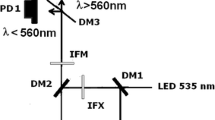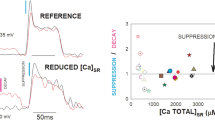Abstract
The intracellular free Ca2+ ([Ca2+]i) regulates the K+ conductance (GK) of the many types of cell membrane1–11. The Ca2+ influx during an action potential activates this [Ca2+]i-linked GK in most neurones2–4,8–11. In caffeine-treated sympathetic ganglion cells, however, Ca2+ released from an intracellular Ca2+ reservoir site analogous to the sarcoplasmic reticulum (SR) of the muscle (see ref. 12) causes activation of the GK, which results in slow oscillatory hyperpolarisations (caffeine hyperpolarisation, C-hyperpolarisation)11. Such a release of Ca2+ linked to the GK of the membrane seems important for understanding the role of the intracellular organelles in the control of membrane activities of a neurone. We report here the mechanism of the slow oscillatory hyperpolarisations recorded from the bullfrog sympathetic ganglion cell in Ringer solution. It is found that these hyperpolarisations are generated by a [Ca2+]i-linked GK system and are highly sensitive to anions in an intracellular recording electrode, probably to intracellular anions.
Similar content being viewed by others
References
Bülbring, E. & Tomita, T. Proc. R. Soc. B197, 271–284 (1977).
Isenberg, G. Nature 253, 273–274 (1975).
Meech, R. W. A. Rev. Biophys. Bioengng 7, 1–18 (1978).
Minota, S. Jap. J. Physiol. 24, 501–512 (1974).
Gardos, G. Biochim. biophys. Acta 30, 653–654 (1958).
Whittam, R. Nature 219, 610 (1968).
Lew, V. L. J. Physiol., Lond. 206, 35P–36P (1970).
Krnjević, K. & Lisiewicz, A. J. Physiol., Lond. 225, 363–390 (1972).
Meech, R. W. Comp. Biochem. Physiol. 42A, 493–499 (1972).
Meech, R. W. J. Physiol., Lond. 237, 259–277 (1974).
Kuba, K. J. Physiol., Lond. (in the press).
Blaustein, M. P., Ratzlaff, R. W., Kendrick, N. C. & Schweitzer, E. S. J. gen. Physiol. 72, 15–41 (1978).
Kuba, K. & Koketsu, K. in Iontophoresis and Transmitter Mechanisms in the Mammalian Central Nervous System (eds Ryall, R. W. & Kelly, J. S.) 158–160 (Elsevier, Amsterdam, 1978).
Kuba, K. & Nishi, S. J. Neurophysiol. 39, 547–563 (1976).
Kuba, K. & Koketsu, K. Prog. Neurobiol. 11, 77–169 (1978).
Endo, M. Physiol. Rev. 57, 71–108 (1977).
Author information
Authors and Affiliations
Rights and permissions
About this article
Cite this article
Morita, K., Koketsu, K. & Kuba, K. Oscillation of [Ca2+]i-linked K+ conductance in bullfrog sympathetic ganglion cell is sensitive to intracellular anions. Nature 283, 204–205 (1980). https://doi.org/10.1038/283204a0
Received:
Accepted:
Issue Date:
DOI: https://doi.org/10.1038/283204a0
- Springer Nature Limited
This article is cited by
-
Inhibition of slow Ca2+‐activated K+ current by 4‐aminopyridine in rat hippocampal CA1 pyramidal neurones
British Journal of Pharmacology (2002)
-
Caffeine-induced oscillations of the membrane potential inAplysia neurons
Neurophysiology (2000)
-
Whole-cell recording of the Ca2+-dependent slow afterhyperpolarization in hippocampal neurones: effects of internally applied anions
Pfl�gers Archiv European Journal of Physiology (1994)
-
The Ca2+-sensitive K+-currents underlying the slow afterhyperpolarization of bullfrog sympathetic neurones
Pfl�gers Archiv European Journal of Physiology (1987)
-
Origin of calcium ions involved in the generation of a slow afterhyperpolarization in bullfrog sympathetic neurones
Pfl�gers Archiv European Journal of Physiology (1983)





